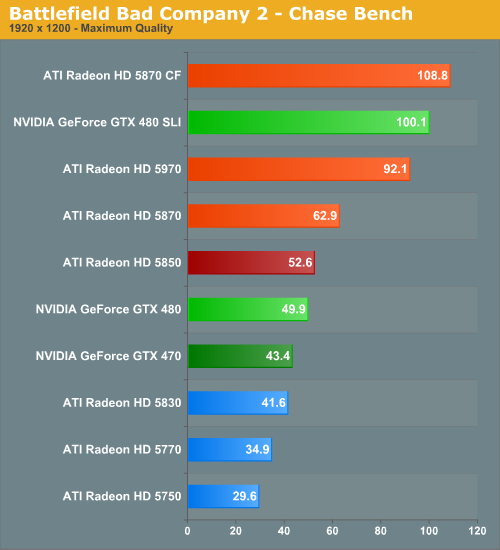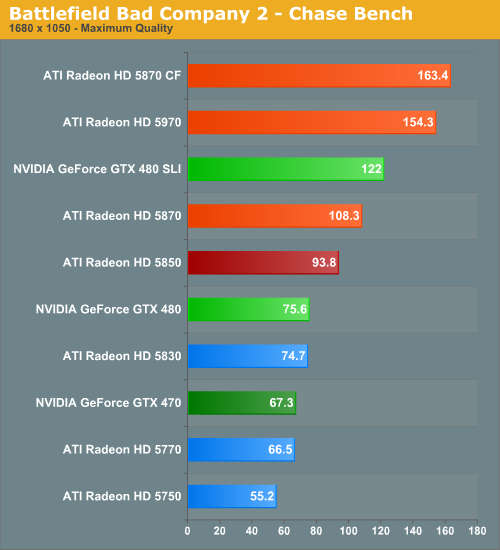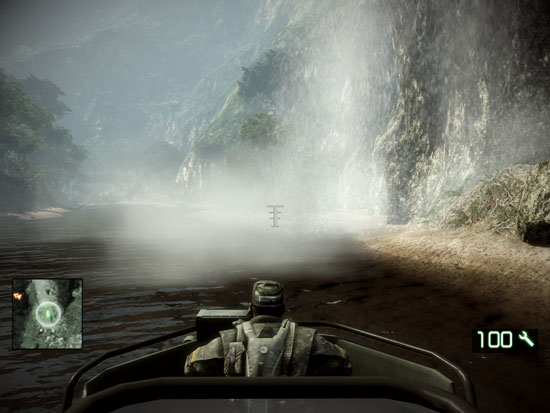NVIDIA’s GeForce GTX 480 and GTX 470: 6 Months Late, Was It Worth the Wait?
by Ryan Smith on March 26, 2010 7:00 PM EST- Posted in
- GPUs
Battlefield: Bad Company 2
The latest game in the Battlefield series - Bad Company 2 - is another one of our new DX11 games and has been a smash hit at retail. It’s also surprisingly hard on our GPUs, enough so that we can say we found something that’s more demanding than Crysis. As BC2 doesn’t have a built-in benchmark or recording mode, here we take a FRAPS run of the jeep chase in the first act, which as an on-rails portion of the game provides very consistent results and a spectacle of explosions, trees, and more.



Unfortunately for NVIDIA this is another losing game for them, and at times they lose big. The GTX 480 comes in at 20% behind the 5870 at 1920, while the GTX 470 comes in behind the 5850 by a similar degree at the same resolution. Interestingly we’re once again seeing a narrowing of the gap as resolutions increase – at 2560, it’s a 9%/7% gap respectively. Given the popularity of the game this really isn’t a game you want to be losing at, particularly by double-digit percentages at 1920.
As FRAPSing the chase scene in BC2 doesn’t provide us with a suitable degree of reliability for minimum framerates, we have gone ahead and engineered our own test for minimum framerates. In the 3rd act there is a waterfall that we have found to completely kill the framerate on even the fastest systems, and in play testing we have found that this isn’t too far off from the minimum framerates we find in multiplayer games. So we’re going to use this waterfall test as a stand-in for minimum framerates on BC2.


Even with a pair of cards in SLI or Crossfire, at 2560 it’s a struggle to stay above 30fps, with only the GTX 480 SLI regining supreme. In fact the performance on this benchmark is quite different from our earlier benchmark all around. Instead of losing the GTX 400 series wins in a big way - a 9% loss in the chase is a 42% lead for the GTX 480 here, and the 470 attains a 35% lead. At first glance we don’t believe that this is a video RAM limitation like we saw in Crysis, but we’re going to have to wait for AMD to ship their 2GB 5870s before we can fully rule that out.
In the mean time it looks like we have two different outcomes: the Radeon 5000 series has the better average framerate (particularly at 1920), but it’s the GTX 400 series that has the better minimum framerate. If you absolutely can’t stand a choppy minimum framerate, then you may be better off with a GTX 400 card so that you can trade some overall performance for a better minimum framerate.










196 Comments
View All Comments
palladium - Saturday, March 27, 2010 - link
clock for clock, the 920 is faster than the 860 thanks to its triple channel memory - the 860 is faster because of its aggressive turbo mode. X58 is definitely the route to go, espeacially if you're benchmarking SLI/CF setups (dual PCIe x16).randfee - Sunday, March 28, 2010 - link
go ahead and try Crysis with 3,33GHz and 4,x, minimum fps scale strangely with the CPU.palladium - Saturday, March 27, 2010 - link
shit double post, srypalladium - Saturday, March 27, 2010 - link
Clock for clock, the 920 is faster than the 860 (860 is faster because of its aggressive turbo mode). Using the P55/860 would limit cards to PCIe x8 bandwidth when benchmarking SLI/CF (unless of course you get a board with nF200 chip), which can be more significant (espeacially with high-end cards) than a OC-ing a CPU from 3.33GHz to 4GHz.Roland00 - Saturday, March 27, 2010 - link
It doesn't really add to the framerates, and having a 4ghz cpu could in theory bring stability issues.http://www.legionhardware.com/articles_pages/cpu_s...">http://www.legionhardware.com/articles_...scaling_...
B3an - Friday, March 26, 2010 - link
You're good at making yourself look stupid.A 920 will reach 4GHz easy. I've got one to 4.6GHz. And a 920 is for the superior X58 platform and will have Tri-Channel memory.
Makaveli - Friday, March 26, 2010 - link
I have to agree with that guy.Your post is silly everyone knows the X58 platform is the superior chipset in the intel line up. Secondly do you honestly think 3.33Ghz vs 4Ghz is going to make that much of a difference at those high resolutions?
randfee - Friday, March 26, 2010 - link
sorry guys but I know what I'm talking about, using Crysis for instance, I found that minimum fps scale quite nicely with CPU clock whereas the difference a quad core makes is not so big (only 2 threads in the game afaik). FarCry 2, huge improvements with higher end (=clocked) cpus. The Core i7 platform has a clear advantage, yes, but the clock counts quite a bit.As I said... no offense intended and no, not arguing against my favorite site anandtech ;). Just stating what I and others have observed. I'd just always try and minimize other possible bottlenecks.
randfee - Friday, March 26, 2010 - link
well.... why not test using the 920 @ 4.xGHz, why possibly bottleneck the System at the CPU by using "only" 3,3?No offense intended but I find it a valid question. Some games really are CPU bound, even at high settings.
Ph0b0s - Friday, March 26, 2010 - link
These new cards from ATI and Nvidia are very nice and for a new PC build it is a no brainer, to pick up one of these cards. But for those like me with decent cards from the last generation (GTX285 SLI) I don't really feel a lot of pressure to upgrade.Most current PC games are Directx 9 360 ports that last gen cards can handle quite well. Even Directx 10 games are not too slow. The real driver for these cards are Directx 11 games, the amount of which I can count on one hand and not very many upcomming.
Those that are out don't really bring much over DX10 so I don't really feel like I am missing anything yet. I think Crysis 2 may change this, but by it's release date there will probably be updated / shrunk versions of these new GPU's avaliable.
Hence why Nvidia and ATI need really ecstatic reviews to convince us to buy their new cards when there is not a lot of software that (in my opinion) really needs them.